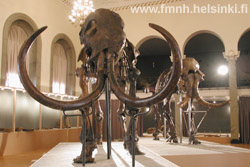 |
||||||||||||||||
Museomics Today's natural history museums are true treasure troves, not only for curious visitors, but also for molecular biologists. Many of the samples used for our projects come from museum collections and are associated with a wealth of additional information that was recorded at the time of collection. An invaluable source of information are the museum curators, who like to know the molecular-genetic characteristics of a given specimen. Since many of these are type specimens, which define a given species, it is of great interest to attach the DNA sequence to a given fossil or specimen in order to facilitate its molecular-genetic comparison with modern samples. Our method of combining museum preservation with next-generation sequencing and comparative genomics has proven to be robust, resulting in complete mitochondrial genomes for many of the most famous mammoth permafrost mummies: |
||||||||||||||||
|
||||||||||||||||
 |
||||||||||||||||
| One example of the robustness
of our approach is the famous
Adams mammoth,
which was found in 1799 by a hunter of the Tungus tribe. The permafrost
mummy was recovered in the summers of 1804 - 1806 by the Russian botanist
Michael Adams on behalf of the Russian Tsar Alexander I. It took several years
of effort and a very substantial amount of funding to unearth and collect
this specimen from the Siberian permafrost. To this day, it is the most
complete skeleton of any mammoth found. It has been continuously on display
at the Zoological Museum in St. Petersburg ever since. Together with the
flesh and bone, large amounts of hair were recovered -- a total of 36
pounds (16.4 kg). The hair was kept at room temperature for the last 200
years, but nevertheless yielded a complete mitochondrial genome together
with DNA sequences from the nuclear genome.
A large number of collections stored in natural history museums are now within reach of molecular genomic analysis. Our proposed analyses of type specimens might therefore open the door to an area we call "museomics" -- the large-scale analysis of the DNA content of museum collections. |
||||||||||||||||
 |